If you’re a Buck Knife enthusiast or collector, knowing how to date a Buck Knife is an essential skill. Being able to determine the age of a Buck Knife can help you evaluate its value, authenticity, and history. Whether you’re looking to add to your collection, sell or trade a Buck Knife, or simply satisfy your curiosity, understanding the age and features of a Buck Knife is crucial. In this article, we’ll explore the various ways to date a Buck Knife, including deciphering serial numbers, identifying distinguishing features, and evaluating construction materials. So, if you’re wondering how to date a Buck Knife, read on to learn everything you need to know.
How to Date a Buck Knife?
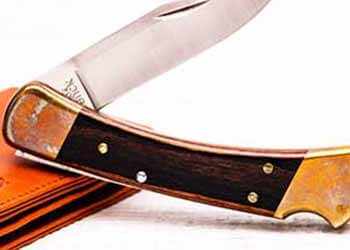
Dating a Buck Knife involves determining the age of the knife. This can be done by examining the knife’s markings, features, and construction. By identifying the age of the Buck Knife, you can evaluate its value and authenticity.
So, how to date a buck knife? Well, there are some special techniques to apply so that you can easily find out the age or date of the knife. Let’s try those.
Stamp Recognition
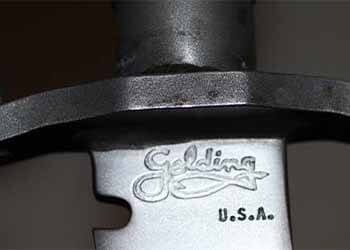
Buck Knives are often marked with stamps that indicate the model, year of production, and other information. By recognizing these stamps, you can determine the age and type of the Buck Knife. For example, some Buck Knives have model numbers that indicate the year of production, while others have date codes stamped on the blade that can be decoded to determine the year of production.
We are providing a table chart in order to recognize the manufacturing date seeing the stamp marks.
This chart will tell you about the knives manufactured from 1961- 86.
| Date | Symbol |
| 1961-67 | BUCK |
| 1967-72 | BUCK, USA |
| 1972-86 | BUCK 110, USA (Added Model #) |
Symbol Recognition
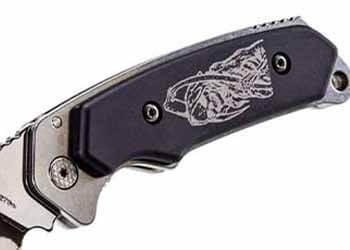
Buck Knives also feature symbols that can help you date the knife. For example, the Buck 110 Folding Hunter knife has a symbol of a deer on the blade, which can indicate the knife’s age and production year. By recognizing these symbols, you can determine the age of the knife. You can check more for matching the symbol you have right now.
Dots on the Knives
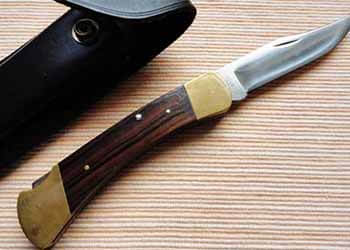
Some Buck Knives feature dots on the handle or blade. These dots can be used to determine the age of the knife. For example, Buck Knives produced between 1961 and 1986 have dots on the blade that indicate the production year. The number of dots corresponds to the last digit of the production year.
However, you can decipher the date easily if the blades of the knives are 110 and 112 models from the dots on the model number.
We’ll categorize 3 periods on the basis of Dots to recognize the knife. Let’s know them.
- 1974-80 – The model number has one Dot both of the sides.
- 1980-81 – One dot to the left side and another two dots to the right side.
- 1982-86 – Both sides have two dots.
Brass Pin Numbers
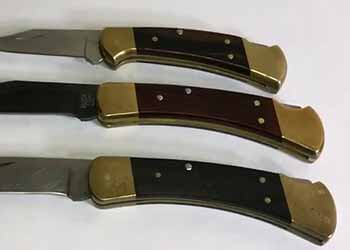
Brass pin numbers are one of the best ways to indicate the manufacturing years. Buck Knives also feature brass pins that can help you determine the age of the knife. For example, Buck Knives produced between 1973 and 1985 have a specific brass pin configuration that can indicate the production year. By recognizing these brass pin numbers, you can determine the age of the Buck Knife.
2-Small Brass Pins – the two small brass pins on the knives indicate the manufacturing date in between 1974 –75.
3-Small Brass Pins – this means the knife was made in 1977.
4-Small Brass Pins – Buck knives were manufactured with four small brass pins in 1976.
3 Large Brass Pins – after the four small brass pins, in 1978-79, buck knives were made with three large brass pins.
Exceptions – In 2002, Buck knives were produced with anvil symbols instead of model numbers, a unique feature for that year. During their 50th anniversary, Buck made two different types of symbols. One had Buck USA and an anvil side by side, while the other had an anvil over the USA.
Related Articles:
- How to Tell How Old a Barlow knife is
- How to Date a Case Knife?
- How to Date a Kissing Crane Knife?
- How to Date a Carl Schlieper Knife?
Some Other Important Applicable Steps to Date a Buck Knife
Dating a Buck Knife requires attention to detail, research, and patience. Here are some important steps to follow when dating a Buck Knife:
- Identify the age of the Buck Knife: Look for markings, such as model numbers, date codes, and symbols that can help you determine the age of the knife. Some Buck Knives also have serial numbers that can be used to determine the production date.
- Understand the type of Buck Knife: Buck Knives come in different types, such as folding, fixed blade, and pocket knives. Knowing the type of Buck Knife you have can help you determine its age and value.
- Evaluate the features and construction of the Buck Knife: Look for unique features that can help you date the Buck Knife, such as different types of bolsters, blade styles, and tang stamps. Evaluate the materials used in the knife’s construction, such as handle material and blade steel, which can impact the knife’s age and value.
- Determine the value of the Buck Knife: Once you’ve dated the Buck Knife, you can determine its value by considering factors such as rarity, condition, age, and historical significance. This information can be helpful if you’re looking to sell or trade the knife.
- Care for the Buck Knife: Proper care and maintenance of the Buck Knife can help preserve its value and prolong its lifespan. Regular cleaning, sharpening, and storage can help prevent damage and wear.
By following these steps, you can successfully date a Buck Knife and gain a better understanding of its value and history.
Some Images Describe How to Date Buck Knives
We are here sharing some images to know how anyone dates buck knives. These images will tell you the symbols, signs, dates, manufacturing years, and so on. So, let’s know those images and chart.
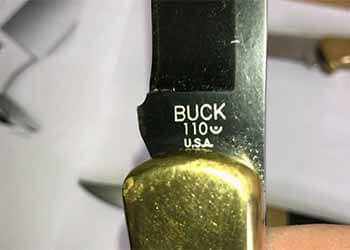
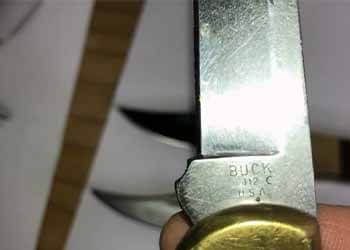

History of Buck Knives
Buck Knives is a brand that has been synonymous with quality knives for over a century. Founded in 1902, Buck Knives has been at the forefront of the knife-making industry, producing a wide range of high-quality knives that are used by hunters, campers, and outdoor enthusiasts worldwide.
Buck Knives was founded by Hoyt H. Buck and his son, Al Buck, in 1902. The first products produced by Buck Knives were knives used for farming and fishing. In 1942, during World War II, Buck Knives began producing knives for the US Military. The knives produced during this time were used by soldiers in the field, and many of them are now collectors’ items.
During World War II, Buck Knives played an important role in the war effort by producing knives for the US Military. Buck Knives produced a wide range of knives, including the famous Buck Model 110 Folding Hunter. This knife was designed by Al Buck in 1964 and was the first folding hunting knife to feature a locking mechanism, making it a safer and more convenient option for hunters.
Buck Knives has expanded its operations, opening a new factory in Idaho in 2005. This new facility allowed Buck Knives to increase production and improve the quality of its products. Buck Knives has also introduced many innovations in knife-making over the years, including the use of high-quality materials like titanium and carbon fiber in its knife handles.
One of the most significant innovations introduced by Buck Knives is the locking mechanism on the Model 110 Folding Hunter. This locking mechanism ensures that the blade stays securely in place when open, reducing the risk of accidents.
Buck Knives is still a family-owned and operated business. The company is now run by the fourth and fifth generations of the Buck family, and they continue to produce high-quality knives that are used by people all over the world.
Buck Knives has a rich history that spans over a century. From its humble beginnings producing knives for farming and fishing, to its current status as one of the most respected knife-making brands in the world, Buck Knives has always been committed to quality and innovation. Whether you’re a hunter, camper, or outdoor enthusiast, a Buck Knife is a must-have tool that will last you a lifetime.
What Do The Symbols On Buck Knives Mean?
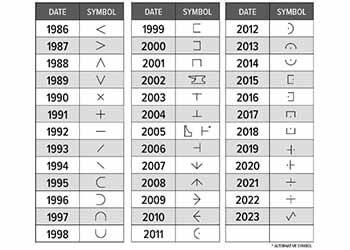
Buck Knives are popular among knife collectors and outdoor enthusiasts alike, thanks to their exceptional quality and craftsmanship. Over the years, Buck Knives has used different symbols on their knives to signify various things, including the model number, manufacturing year, and special events. Understanding these symbols can help collectors date and identify their Buck Knives. Now, we will delve deeper into the different symbols used on Buck Knives and their meanings.
Model Numbers: Buck Knives usually have a model number stamped on the blade. This model number indicates the type of knife and its features. For example, the model number 110 Folding Hunter is a popular Buck Knife model that features a locking mechanism and a clip point blade. The model number is usually located on the base of the blade or on the tang.
Manufacturing Year: Buck Knives also use symbols to indicate the manufacturing year of the knife. This is useful for collectors who want to date their knives. One symbol that is commonly used is a code consisting of a letter and a number. The letter represents the production year, while the number represents the quarter of that year. For example, “A” represents 1987, “B” represents 1988, and so on. The number “1” represents the first quarter of the year, while “4” represents the fourth quarter.
Special Events: Buck Knives has also used symbols to commemorate special events. For example, on their 50th anniversary, Buck Knives used two symbols on their knives. One symbol had “Buck USA” and an anvil side by side, while the other had an anvil over the USA. Another example is the Buck 110 50th Anniversary knife, which has a special stamp on the blade that says “50 Years” to commemorate the occasion.
Let’s know some symbols of the Buck knives.
- Less Than Sign – This symbol means the knife was made in 1986.
- Greater Than Sign – In 1987, the knives had greater than signs.
- C – The symbol ‘C’ indicates the knives were made in 1995.
- V – ‘V’ symbols are given to the knives made in 1989.
- Inverted V – During 1988, the knives had ‘Inverted V’ on them.
The symbols on Buck Knives carry significant meaning and can provide valuable information to collectors and enthusiasts. Understanding the model numbers, manufacturing year codes, and special event symbols can help identify and date Buck Knives accurately. Read more.
Frequently Asked Questions
Q: How old are buck knives?
A: Buck Knives has been in business since 1902, and the age of a Buck knife can be determined by its markings, including the model number, symbol, and year stamp. Many older Buck knives are considered collectors’ items and can be quite valuable.
Q: How do I determine the age of my Buck knife?
A: You can determine the age of your Buck knife by examining its markings, including the model number, symbol, and year stamp. Buck has used various dating systems over the years, so it’s important to research the specific system used during the time period in which your knife was manufactured.
Q: What do the symbols on Buck knives mean?
A: The symbols on Buck knives indicate the year of manufacture, the model number, and other details about the knife. For example, the anvil symbol was used on Buck knives in 2002 to commemorate the company’s 100th anniversary.
Q: How can I tell if my Buck knife is a collector’s item?
A: There are several factors that can make a Buck knife a collector’s item, including its age, rarity, and condition. Knives with unusual markings or symbols, limited production runs, or historical significance may also be highly sought after by collectors.
Q: What is the significance of the dots on Buck knives?
A: The dots on Buck knives indicate the decade in which the knife was manufactured. For example, a knife with two dots on the blade indicates it was made in the 1980s.
Q: Can I date my Buck knife using the stamp on the blade?
A: Yes, you can often determine the age of a Buck knife by examining the stamp on the blade. However, the stamp alone may not provide enough information to accurately date the knife, especially if it was made before the 1960s.
Q: What does it mean if my Buck knife has brass pins?
A: The number and size of brass pins used in Buck knives can help identify the year of manufacture. For example, knives made in 1974-1975 typically have two small brass pins, while those made in 1978-1979 have three large brass pins.
Q: Are Buck knives made in the USA?
A: Yes, Buck knives are primarily made in the USA, although some models are also manufactured in other countries.
Q: How has the dating system for Buck knives changed over time?
A: Buck has used various dating systems over the years, including symbols, model numbers, and year stamps. The dating system used can depend on the specific time period and the type of knife being manufactured.
Q: Can I date my Buck knife if it doesn’t have a model number or symbol?
A: It may be more difficult to accurately date a Buck knife if it doesn’t have a model number or symbol. However, you may still be able to use other identifying features, such as the blade shape, handle materials, or tang stamp, to narrow down the possible date range.
Q: What should I do if I can’t determine the age of my Buck knife?
A: If you’re having trouble determining the age of your Buck knife, you can contact the company directly or consult with a knife expert or collector. They may be able to help you identify the age of your knife based on its unique features and markings.
Final Words
In conclusion, learning how to date a Buck Knife can be an enlightening experience for knife collectors and enthusiasts. By carefully examining the various markings, materials, and design features of the knife, one can gain valuable insights into its history, craftsmanship, and cultural significance. However, it is important to exercise caution when buying vintage or antique knives, as there are many counterfeit or altered knives on the market. By conducting thorough research and consulting with trusted experts, one can ensure that they are acquiring an authentic Buck Knife. With its legacy of quality craftsmanship and rich history, a Buck Knife can be a treasured addition to any collection and a prized possession for generations to come.
Read More:

